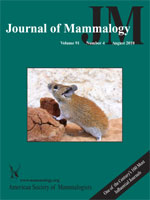Southern flying squirrels (Glaucomys volans) face a dilemma: winter aggregation is beneficial for thermoregulation but costly due to nest mates pilfering stored food in the home area and the tendency for groups to attract predators. Living with kin in winter aggregations may mitigate these deleterious effects because if an individual dies, its stored food can be beneficial to relatives, thereby increasing inclusive fitness. Southern flying squirrels from 7 populations and a captive colony were genotyped at 6 microsatellite loci. We calculated group mean relatedness and dyad relatedness within groups. In the wild, winter populations were found to be more highly related than expected by chance. Fifty-seven percent of animals were associated with a highly related individual in their winter aggregation. We show that southern flying squirrels have a preference for relatives as winter nest mates.
How to translate text using browser tools
16 August 2010
Genetic relatedness in winter populations of seasonally gregarious southern flying squirrels, Glaucomys volans
Katherine K. Thorington,
Jackie D. Metheny,
Matina C. Kalcounis-Rueppell,
Peter D. Weigl
ACCESS THE FULL ARTICLE

Journal of Mammalogy
Vol. 91 • No. 4
August 2010
Vol. 91 • No. 4
August 2010
Glaucomys volans
group nesting
kinship
microsatellite DNA
southern flying squirrel
winter aggregation




